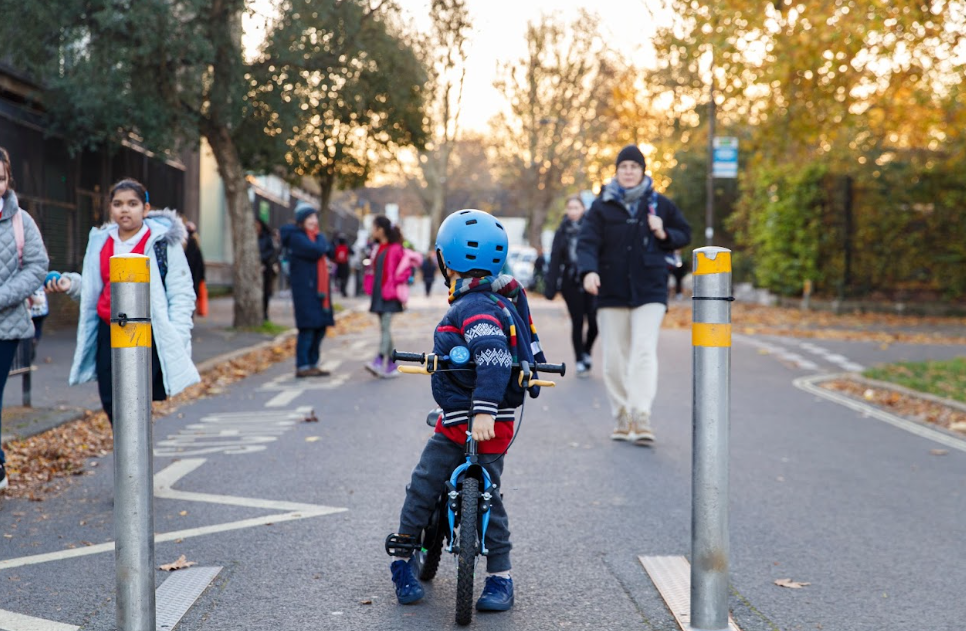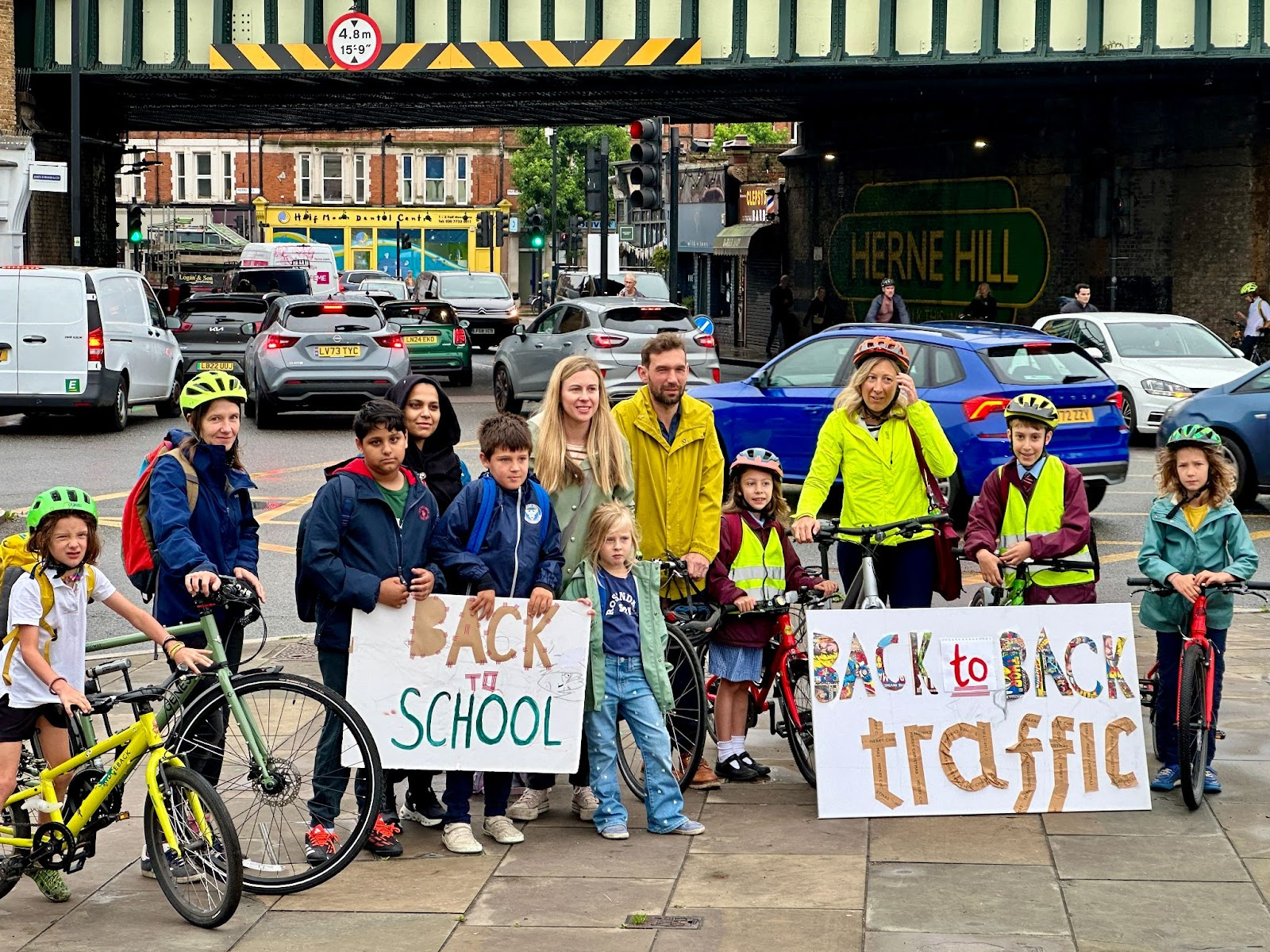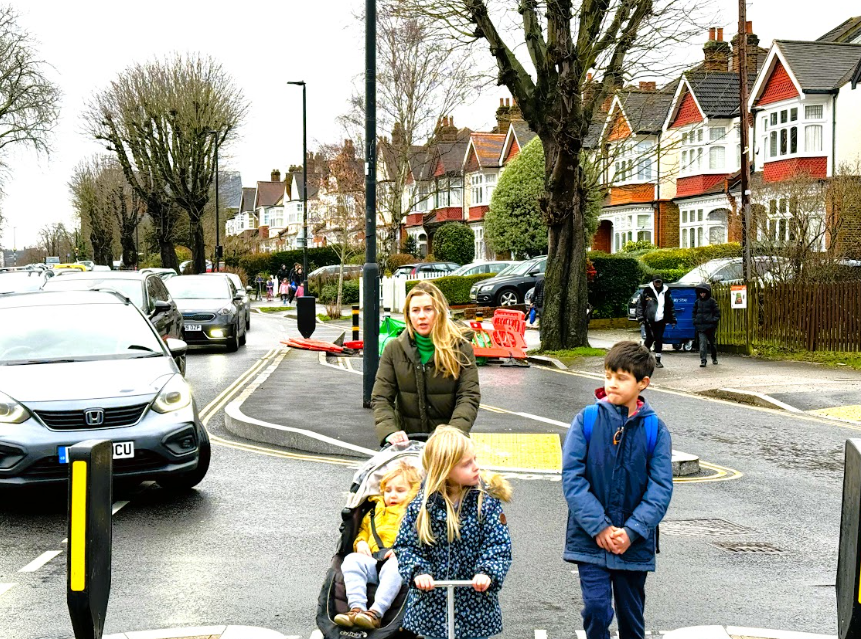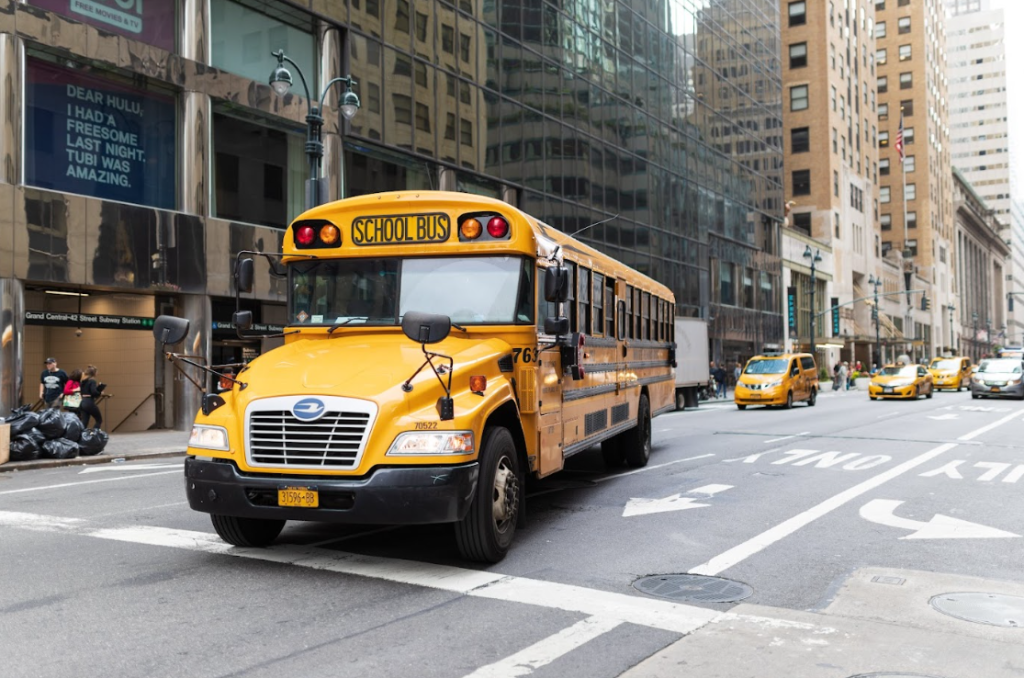- State school pupils would have to walk to school at 5am to enjoy air as clean as during the private school holidays.
- Bus journeys take over 50% longer during school term time.
- Call for more support for school buses and family cargo-bikes.
Private schools are driving a near 50% increase in pollution and traffic, despite serving a minority of pupils, according to new data produced by parent campaigners, ‘Solve the School Run‘. (1)

A school street in Southwark making the school run safer and cleaner. Credit: Bessemer Grange PTA
Analysis of official air pollution and bus journey data from south London shows a major increase in congestion and air pollution with the start of the private school term.
Nitrogen Dioxide (NO2), a damaging air pollutant which comes from burning car fuel, increases by 16% when state schools are in term, but that surges to 47% when private schools go back. (2) Long term exposure to NO2 is associated with serious health conditions including asthma, COPD and cancer while short-term exposure can cause inflammation of the airways and increased susceptibility to respiratory infections and allergens. (3)
The research focussed on Herne Hill and Dulwich in South London, but similar experiences have been reported in other areas of London and in Oxford. (4) The data was compiled by analysing the Mayor’s Breathe London air pollution data from October 2023 to August 2024, looking at when private and state schools are on holiday, and then during term time, as well as examining bus journey times from Transport for London.
The data shows state school pupils in this area are exposed to considerably lower air pollution when walking to school during the private school holidays. Indeed, during private school term times, state school pupils would have to walk to school at 5am to enjoy air as clean as during the private school holidays.
The charity Solve the School Run are calling for:
- Staffed walking lines and ‘bike buses’ to cater for working parents.
- Investment in school buses for primary pupils from private schools.
- School streets which have timed closures around school drop off and pick up times.
- More cycle paths and storage facilities to support parents using cargo bikes.
Across the capital, nearly a quarter of pupils in London (24%) are driven to primary school every weekday, causing a major spike in congestion and air pollution. This equates to an extra 240,000 car trips on the roads during each of the morning and afternoon rush hours. (5)

Solve the School Run volunteers highlight the traffic associated with the return to school. Credit: Solve the School Run
Nicola Pastore, a data analytics consultant and co-founder of Solve the School Run said: “The data is clear – we are all affected by the school run, whether we are bus passengers, dog-walkers or families on our way to school. Solve The School Run wants to see better data on these journeys, much safer travel routes to schools for walking and cycling and parent-free travel options like staffed bike buses and school buses.”
The Walking and Cycling Commissioner for London, Will Norman said: “We know that the majority of children walk or cycle to school, and the Mayor and I are doing everything we can to encourage more Londoners to choose active and sustainable transport for shorter journeys. TfL has quadrupled the number of cycleways since 2016, and we’re working continually to make intimidating roads and junctions safer.
“There are also now over 500 School Streets across London, as well as more than 100 Low Traffic Neighbourhood schemes, which also make it safer and easier for families to get around their local area on foot and by bike. We’re calling on families in London to consider walking, cycling or using public transport for the school run, not just for environmental but for safety and health benefits, to build a better, fairer and greener London for all”.

Nicola Pastore, a parent in South London doing the school run. Credit: Solve the School Run
“Most days my kids and I cycle the two miles to their independent school. Otherwise we take the train and then walk/scoot the 10 minute journey from the station. Much of the bike ride is joyful thanks to closed roads and school streets. But it’s a different story near the school, where there is no bike lane and heavy traffic. Walking along the same main road from the station is also unpleasant. I want safe options for all families, so they can leave the car at home. If we can reduce the school run traffic, the air around the school will be cleaner and the roads safer for everyone,” says Kate Hampson, a South London parent and member of Solve The School Run.
A wider issue
The South London situation has been reported in other areas in the capital, as well as in Oxford. Parents and residents complain of similar trends in Hampstead, Wandsworth and Richmond, which all have similar concentrations of schools, particularly private schools.
Research from Cllr Emily Kerr in Oxford found that up to 50% of congestion during the school run was caused by the city’s private schools. (4)
Cllr Emily Kerr said: “We see a clear trend in Oxford where private schools make up about 30% of pupils but a significantly higher percentage of school run traffic within the city. Many pupils at private schools live further away than those at state schools, so these journeys can be harder for families to walk and cycle. One solution would be for private schools to invest in mini-buses for all age-groups. These would provide a cost-effective and convenient alternative to driving for parents. We are delighted to see some schools in Oxford starting to do this, and we hope that private schools in other areas of the country where there are the same school run traffic issues follow suit.”
“Congestion and air pollution soars when the private schools go back to school, making the school run (however you do it) unpleasant and dangerous. In fact, it’s so awful, we set up our own charity to help try and combat it,” says Francesca Agostini, Green School Runs and mother of two, who lives in Hampstead.
“It’s really interesting to see higher levels of air pollution correlating so closely with term time. We know that road transport is an important cause of both nitrogen dioxide and particulate matter. We’re really pleased to see communities using their local data from Breathe London to shed light on causes of pollution in their neighbourhood and campaigning to reduce it,” says Professor Ben Barratt, Environmental Research Group at Imperial College London.
Featured photo by Anton Massalov.



